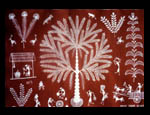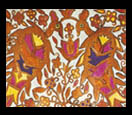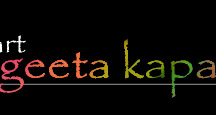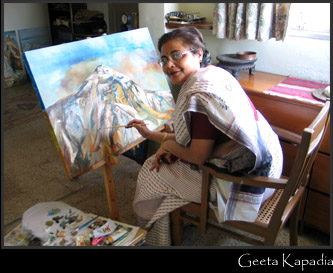Geeta
Kapadia
Geeta
has trekked extensively through the Western Ghats and the Himalayan
ranges and takes keen interest in the art and artists of these regions.
She conducts workshops for university and school students reintoducing
them to their heritage of Indian folk art.
She has worked as a freelance artist for the Indian-Post,Heritage
and the Himalayan Journal.
She has written and illustrated a book containing her inksketches
and experiences on the Himalayan treks entitled 'The Himalaya In My
Sketch-book '.
Geeta Kapadia has been associated with many educational institutes
in Bombay and has given illustrated talks and workshops to students
on the folk art forms of India.
WORKSHOPS
I conduct Workshops on various Indian folk Arts.
It has also been
the tradition in my village in Goa to draw Rangoli with white powder
and
colour its forms using pigments for festivals and rituals. My training
as an artist is rooted in folk art. Folk art forms in India are a
living tradition. A tradition which continues to evolve through the
incorporation of modern symbols which add a further dimension to the
art thus assimilating a variety of cultures into these folk art forms.
I have been trekking
and travelling in the Western Ghats and in Himalayan ranges, since
my college days. I took a keen interest in various folk arts in the
Indian villages,
and in my travels and treks, I had plenty of opportunities to learn
the many forms of folk art; much of this as after gaining experience
in various forms of folk art,
I conduct work-shops
on these different forms of art.
The practical
nature of drawing and painting these forms enables the participant
to gain a holistic experience of the style. This is permanently recorded
as impressions on the
mind, so a work-shop is an actual cultural experience for an
individual. There is total freedom of expression in folk art.
There is a very interesting exchange bwteeen the participants and
the teacher.
These workshops are suitable for all ages and people with limited
or no knowledge of art.
A Short- Note
On The Indian Folk Art
RANGOLI PAINTINGS
Rangoli is is a popular art form in all the homes in India,each region
has it's own variations .
The skill is simple, the scope infinite. This floor decoration originated
as a form of thanksgiving to the Earth Mother.
WARLI
TRIBAL PAINTINGS
Wall
paintings of the Warli tribe are one of the most ancient forms of
art known to civilisation. Painted on the mud plastered wall with
white rice flour, Warli art is a pictograph which narrates the cycle
of life in nature and its relation to man.



MITHILA
PAINTINGS
It was in the city of Mithila Sita was married to Rama. The walls
of Mithila were painted by the people to welcome Rama and to celebrate
their wedding. The tradition still continues in Mithila although this
folk art is now transferred on paper for urban dwellers.





HIMALAYAN
THANGKA PAINTINGS
Thangka
(Scroll )paintings in Buddhist style from the Himalayan regions of
India.
These paintings celebrate different attributes of Buddha in the form
of deities and symbols.
This is a deeply symbolic style and each Thangka has a meaning. They
are often used as
aids to meditation and each colour used within them has a special
spiritual significance.
BLOCK PRINTING (ON HAND-MADE PAPER)
Block printing on paper and cloth follows the great tradition
of weavers in India.
There is variety of styles in this folk art yet it conveys a design
simplicity which is easily followed by village women.
All these folk
art forms are vivid and part of a living tradtion. These workshops
provide an infinite scope development and may be seen as stepping
stones in the artisitc development of the participant or as a complete
process in themselves.

















